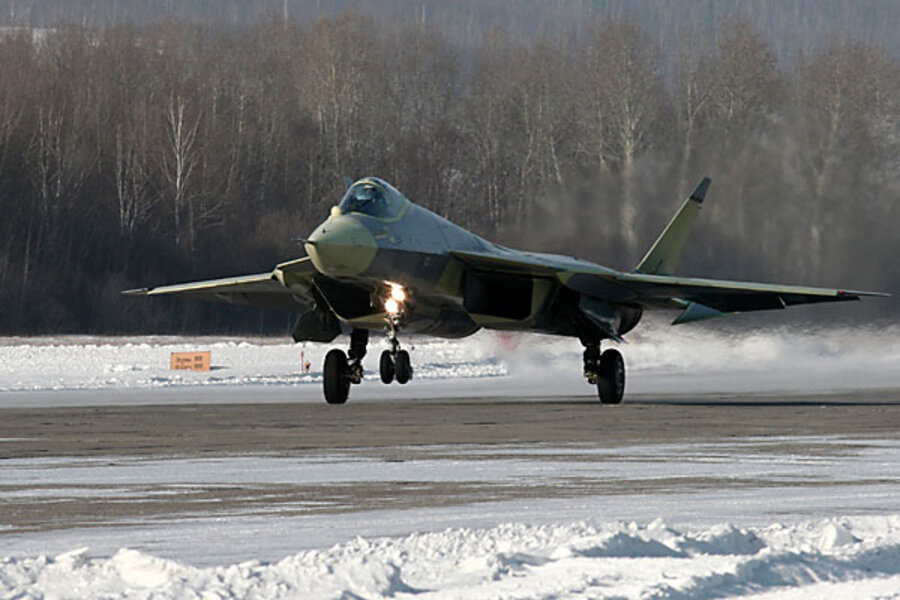Russia flexes military power with 'futuristic' fighter jet
| Moscow
Vladimir Putin is jubilant, the Russian aviation industry is filled with pride, and even normally skeptical military experts say they're truly impressed by reports Friday that Russia has successfully test-flown the first prototype of a "fifth generation" fighter plane.
They all may have good reasons to cheer. Building such a plane is so expensive, complex, and technologically sophisticated that, until now, only the United States has been able to field an operational version of one: the F-22 Raptor.
According to news reports, Russia's venerable Sukhoi company – maker of many famous Soviet warplanes – sent the V-tailed, swept-wing Sukhoi T-50 on its maiden flight for 47 minutes Friday near Komsomolsk-na-Amur in Russia's far east (see video here) and it exceeded all expectations.
"We started flight tests of the fifth-generation aircraft today," Sukhoi CEO Mikhail Pogosyan told Russian news agencies. "I am strongly convinced that this project will excel its Western rivals in cost-effectiveness and these planes will constitute the backbone of the Russian Air Force for the next few decades."
A fighter of the "fifth generation" should have futuristic characteristics of stealth, sustained supersonic cruise, multi-role capabilities, integrated weapons and navigation systems that are controlled by artificial intelligence, over-the-horizon radar visibility and other cutting-edge wizardry.
Experts say that the mere fact that Russia can put one into the air announces its return to the global stage as a first-rank military and technological power.
"This is an epic event, because it's the first time in post-Soviet history that [the Russian military industry] has been able to create something brand new," Alexander Khramchikhin, an expert with the independent Institute of Political and Military Analysis in Moscow, says in a telephone interview.
"Everything we produced after the USSR's collapse was based on Soviet designs; nobody thought we could make anything so technologically complicated as this. But now, strange as it may seem, this shows Russia's level is very high."
Kremlin leaders have been promising to build this new aircraft for years as part of a broader effort to re-arm and modernize Russia's crumbling Soviet-era armed forces. Though Russia handily won its brief 2008 war with neighboring Georgia, the conflict revealed massive shortcomings in its military machine, including disastrously poor air support for ground forces and almost nonexistent aerial reconnaissance capability.
Prime Minister Putin praised the T-50's first flight as a "big step" in restoring Russia's traditional place as a global military power, and pledged that the air force will start receiving production models of the plane in about three years.
As Russia's president, Putin launched a sweeping, $200-billion rearmament program that aims to introduce new generations of nuclear submarines, intercontinental missiles, tanks, and aircraft carriers for the armed forces within the next five years.
Experts say the T-50 fighter, which has been developed in partnership with Russia's leading arms client India, will also go far toward restoring the tattered reputation of Russia's military-industrial complex as a leading supplier of weaponry in global markets.
"This is really good advertising; it shows buyers of Russian-made hardware that we can produce the most modern weapons and also improve them," says Vitaly Shlykov, a former Soviet war planner who now works as a civilian adviser to the Russian Defense Ministry.
"We invested a lot in this plane, and the fact that we can fly it has a big psychological impact," he says. "It has a huge symbolic meaning for Russia itself."
But skeptics say we'd best wait for more details about the top-secret plane of which we have seen, so far, only a few superficial images.
"We see the plane has some external characteristics that are new, but we have no way of knowing whether it actually possesses the technological features that would make it a fighter of the fifth generation," says Alexander Golts, military expert for the independent Yezhednevny Zhurnal, an online news magazine.
"It's great that it took off. Hurray. But I want to know a lot more about it."





